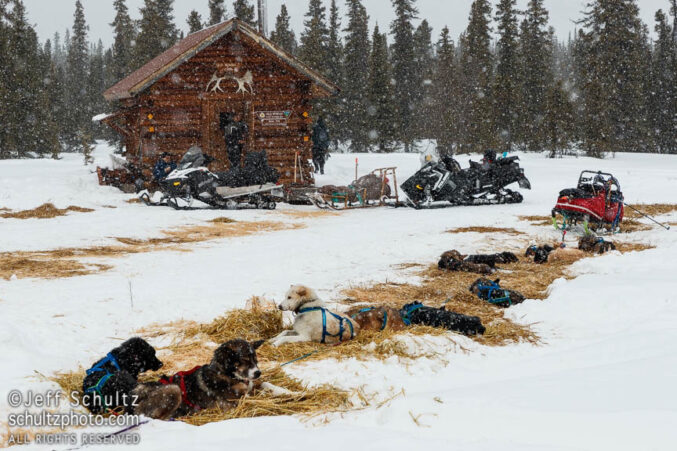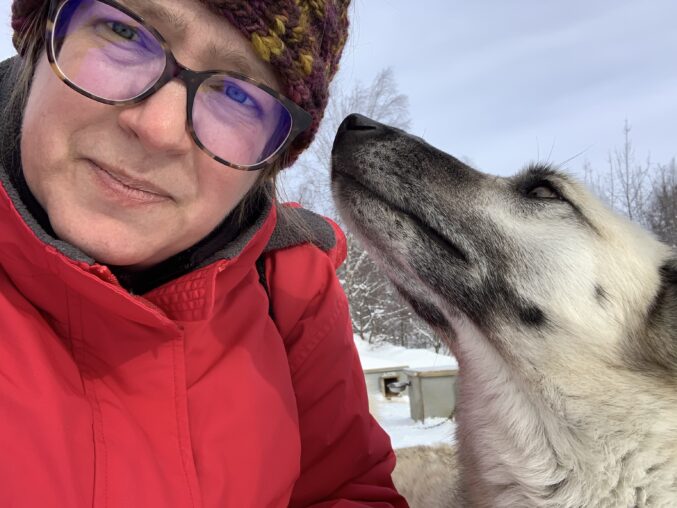As expected with the pace at the front of the pack picking up, the distance from leader to the final musher has lengthened. Unalakleet (you-na-la-kleet) sits at mile 714 with teams about two-thirds of the way there from Kaltag. Tracker shows seven top contenders resting at mile 676. Tracker also shows Erin Altemus and Bryce Mumford as departed from Ruby at mile 495. So teams are spread out over a distance of about 180 miles. Yesterday’s morning spread was 157 miles, the day before 150 miles.
Why would teams rest along the trail between Kaltag and Ruby? The distance between the Yukon River checkpoint and the Bering Sea Coast checkpoint is 85 miles, generally too long for a straight through run although folks have done it with strategic rest on the Yukon. Ryan Redington did so in 2023 on his way to gold.
The portage trail has two safety cabins often used by mushers during the 85 mile run. The Tripod flats cabin is located about 35 miles inland from Kaltag. The Old Woman cabin is located about 35 miles inland from the Bering Sea. Many mushers choose to stay at one of the cabins to break up the long run. Some choose to camp twenty miles out from Unalakleet in the shelter of a forest.

Team rests at the Old Woman cabin on the run from Kaltag to Unalakleet.
Photo by Jeff Schultz/ (C) 2019 ALL RIGHTS RESERVED
It looks like Beals, Redington, Drobny, Hall, Seavey and Kaiser are all at Old Woman shelter cabin at mile 676. No secret stealthy moves in the top seven with all camping in the same location. Beals rested outside of Kaltag after receiving the Fish First Award. Now he’s resting his 10 dog team for the second time on this run.
Jessie Holmes has departed the cabin for Unalakleet. The first musher to the Bering Sea Coast will be honored by Ryan Air with the Gold Coast Award. The winner receives $1,500 in gold nuggets and a carved ivory sled dog team. By no means is the first musher to the Gold Coast always the first musher to the burled arch.
Back of the pack musher, Erin Altemus, grew up in Glenwood City, Wisconsin. Her second and fifth grade teachers both used Iditarod as a theme for education with their students. Today Erin is doing the Iditarod trail. Can’t help but wonder what role those two teachers had in igniting a burning desire to do the race for Erin.
There are thousands of teachers around the world who use the amazing sled dog and races such as the Iditarod for real life learning situations. Was it fun to learn about landforms from a text book? Wouldn’t it be more interesting learning landforms by using the 1,000 mile Iditarod Trail and the mushers who travel the trail.
There was a group of 4K kids in Huslia that walked through musher parking in 2017 counting dogs on resting teams then decided which team had less or more dogs. Story problems in math, oh the Iditarod offers countless applications. STEM – combining science, technology, engineering and math – try a build a better sled project.
The Iditarod offers applications for every subject area – math, science, geography, history, language arts, health, physical education, music, art, business and social emotional learning. It offers applications that can reach all grade levels pre-school through high school.
The Education tab on the Iditarod webpage has hundreds of lesson plans ready for teacher to use. There have been 25 teachers who have served since 1999 as the Iditarod Teacher on the Trail. Kate Newmyer of Texas is currently in Unalakleet acting as the liaison between classrooms and the trail during the race. Beginning last August Kate has posted lesson plans each month that teachers can borrow and tweak or use as is with their students for curriculum enrichment and motivation.
While being on the trail Kate has posted lesson ideas each day – Big Ideas, Creating Community, Artistic Moments, Sensory Language, Depth Perception and Probability to name a few. If you are interested in becoming the Teacher on the Trail, there is more information under the Education tab on Iditarod’s webpage.



































